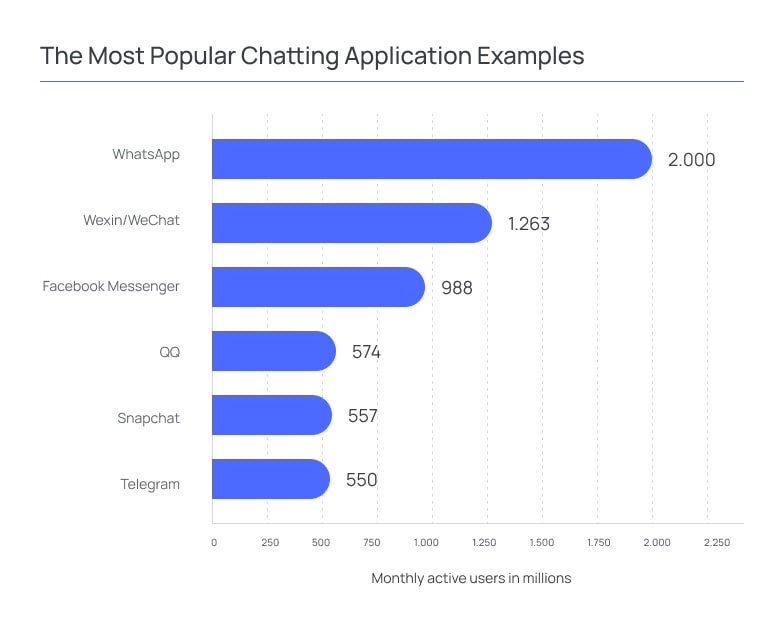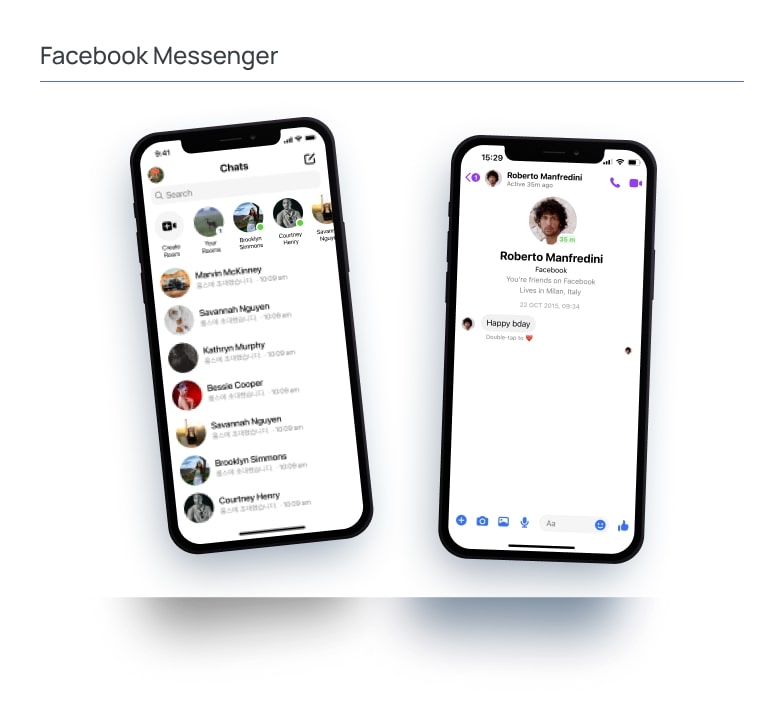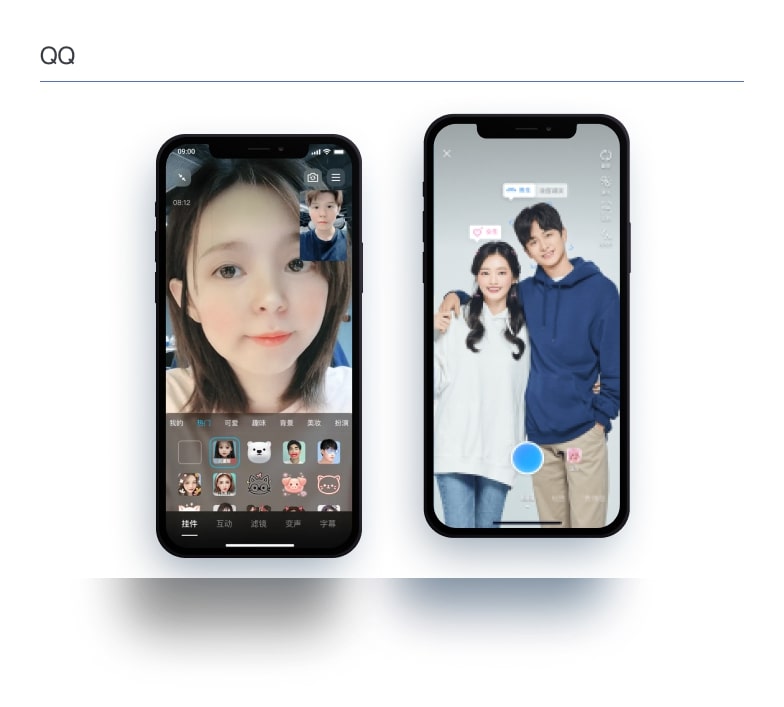Instant messengers are as popular as social media. There are more than 3 billion chat application users globally, and their number is projected to grow. Let’s meet their demand for secured and quick communication and data sharing by creating a chatting app with a market-disruptive potential.
Why Do People Use Messaging Apps?
Before getting started with creating a messaging app, let’s briefly uncover their use cases so that you can better tailor the future functionality to the core expectations of your target audience.
Here is why people use messaging apps, and the winning combo of multiple opportunities for communication is what makes chatting solutions globally popular.
- Stay in touch with family and friends. This is the first and the most obvious reason why people use messaging apps. The first messenger ever, ICQ (I Seek You) was created in 1996 just with the goal of making user-to-user communication cheaper compared to using mobile networks.
- Business communication. Since 1996, messaging apps have evolved from simple chatting solutions to all-in-one platforms that are pretty effective for business communication. What’s more, there are dedicated business-only chatting apps that are specifically tailored to the team communication needs, for example, Slack or Discord.
- Interacting with favourite brands. 45% of modern customers prefer getting in touch with a business via a messaging app, instead of calling or writing an email. What’s more, 27% of them strongly believe that a business should be available to reach out to 24/7 which is one of the reasons for in-built chatbots’ popularity growth.
- Media content consumption. In addition to the messaging app use cases highlighted above, the users choose them to consume media content and follow favourite brands, opinion leaders and thematic channels.
The Most Popular Chatting Application Examples

So, in 2024, the most popular chatting apps are WhatsApp, WeChat, Facebook Messenger, QQ, Snapchat and Telegram. In one of our recent articles, we have already discussed how to create an app like Snapchat, and now let’s uncover some stats and facts on the globally-leading messaging solutions.
- Target market: the US
- Number of users: 2,000 million
- Users demographics: 26-45
- Business model: Additional services (What’s App for Business, What’s App Pay)

Wexin/WeChat
- Target market: China
- Number of users: 1,263 million
- Users demographics: 25-44
- Business model: Selling additional services, advertising

Facebook Messenger
- Target market: Global
- Number of users: 988 million
- Users demographics: 25-34
- Business model: Advertising in Facebook Messenger for Business

- Target market: China
- Number of users: 574 million
- Users demographics: 19-30
- Business model: Freemium

Snapchat
- Target market: India and the US
- Number of users: 557 million
- Users demographics: 18-24
- Business model: Advertising

Telegram
- Target market: India and the US
- Number of users: 550 million
- Users demographics: 25-34
- Business model: Subscription, selling sponsored messages

How Do Chatting Apps Make Money?
- Subscription. A well-familiar SaaS tactic can perfectly work for chatting apps as well. For example, What’s App followed it at the very beginning of its existence, allowing the users to use the app for free during the first year, and then subscribe for just one dollar.
- Freemium. Freemium means offering the basic features for free, while more advanced functions are paid. This is the model used by QQ messenger.
- Value-adding services. This is the model followed by What’s App now. Now, it offers What’s App for Business and What’s App Pay services, in addition to the basic application. WeChat follows the model as well.
- Advertising. This is the top tactic most of the apps follow to let the users use the solution for free and become better recognizable. For instance, with the help of Facebook Messenger, businesses can promote their ads. For Snapchat, advertising is the stream of 99% share of its income.
Mixed model. A mixed model, as the name suggests, implies combining the best features of the possible approaches into a holistic one. For instance, Telegram offers a subscription, plus allows for selling sponsored messages.
Essential Features to Build a Chat App
In one of our recent articles, we have already dwelled on how to create an app like Instagram. Since Instagram also has in-build chatting features, you are welcome to check it for add-on ideas and inspiration.
Below are the must-have functions to create a messenger MVP.
- Secured log-in. A secured onboarding is the first essential thing you have to create for your future app. Most modern messengers allow for logging in with the help of a mobile phone number, barcode scanning via the main device or with biometric authentication.
- Text and voice messaging. This is the core feature of a chatting app. When designing it, make sure to provide users with a familiar and comfortable environment for message exchange, plus add the opportunity to record voice messages. The last feature is on an unprecedented rise in popularity. Whats App users alone send 7 billion voice messages every day.
- Search for the users. With the help of this feature, the users should be able to find other people, channels or groups. Telegram is a perfect example of how this function works.
- User profile. Then, let the users add a personal touch by customizing their profiles, choosing light or dark mode and chat wallpapers, notification sounds and so on.
- Notifications. Notifications are another core feature to engage the users and give them an opportunity to communicate with each other in a flash.
- Encryption. Encrypting the data the users share is a must for any modern messenger. Encryption means that nobody can access the shared data except for the users themselves.
To date, Signal is considered the most secured and best-encrypted chatting app since even Signal itself cannot access the data exchanged. Telegram also stands out with its security features. The messages sent via it leave no trace on the servers and can never be restored after deleting.
Cloud and data synchronization. This feature means using a secured cloud server for data storage, while the data itself should be instantly synchronized after the app is updated, reloaded or accessed from the other device.
What Tech Stack to Use for Building a Chatting App
| Messaging App | Technologies |
| Erlang, FreeBSD, Yaws, PHP, and XMPP | |
| JavaScript, Node.js, jQuery, HTML5, and GitHub Pages | |
| FB Messenger | React, PHP, Jenkins, GraphQL, and Confluence |
| Snapchat | Bootstrap, Javascript, Python Objective),Cocoa Touch and PHP |
| Telegram | JavaScript, Java, Android SDK, Objective C, C++, C, Cocoa Touch |
Choosing the right tech stack is essential to building a messaging app. Below are the tech choices made by the leading chatting applications. Keep in mind that all of them are developed as native applications for iOS and Android, plus have a separate web version.
How to Make a Chatting App Step by Step
So, here is how to make a chatting app. Generally, the process hardly differs from creating a solution from any other type but you have to keep fierce competition in mind when building a messaging app and promoting it to the target market.
1. Decide on the unique value proposition
99,9% of the chat app features are similar so standing out can be a challenge. However, there are still ways to develop a unique value proposition and make a chat app easily recognizable. So, think about creating something advanced, for example, embedding augmented reality (but not in the same way Snapchat does), integrating an app with a smarter chatbot or e-wallet or adding additional security features nobody offers now.
2. Find a development partner
There are several ways to develop a chat app. For instance, you may use dedicated application builders or no-code platforms but their major drawback is the significant lack of customization opportunities and possible security loopholes.
So, to avoid such pitfalls, chat app development should be custom and professional. That’s why getting in touch with a dedicated development vendor would be a wise solution, especially when the tech company can create a social media app or chatting solution using their previous experience.
For example, Ukrainian developers have outstanding experience in creating projects for social media niches. They stand out in the software development outsourcing market with their hands-on expertise and strong engineering education, while the cost to hire developers in Ukraine is pretty competitive.
We, at Binerals, also specialize in developing software for the media and entertainment industries, so you are welcome to reuse our insights and create a winning chat app together.
To get started with chatting application development!
Contact us now3. Validate the tech stack and design solutions
Choosing the right tech stack and validating the design solution are the next steps in chat app development. As you can see, the most popular messaging apps have JavaScript at the heart of their web versions, plus use native-specific programming tools to build different solutions for Android and iOS.
While the tactic to build two separate apps and a web version is a pretty right one, such a strategy is also the most expensive. That’s why it makes sense to get started with either one of two native apps or choose affordable and coding speed-boosting technologies like Flutter. At this step, make sure to consult your development vendor to choose the most winning tech stack for your future app.
As for the design solutions, there is no need to reinvent the wheel when creating a chatting app. Following the best UI/UX practices established by the market leaders would be a wise decision in this case.
4. Build, test, repeat
Now, it’s time to create a chat app and test it, making sure there are no UX flaws and data security gaps. Make sure to run both manual and automated testing scenarios to avoid critical bugs and errors.
After the MVP is free from technical loopholes, it’s time to launch it to market, test its performance with the target audience, gather their feedback, and proceed with the app maintenance and improvement.
We, at Binerals, can support you along the chat app development path! Book a call with our developers now to make the first step!
Conclusion
For instant tech support
Contact us nowFAQ
Where to hire software developers to build a great chatting app?
There are several software development outsourcing destinations to consider, and Ukraine is one of them. Ukrainian developers make a perfect match when it comes to the price-quality ratio, the ease of communication and outsourcing the project development to this country.
What tech stack should I use for my messaging application?
Most chatting applications use JavaScript for creating a web version of the app, and OS-specific tools to build native solutions. You are welcome to meet our developers for individual consultation and personalised suggestions.
How much does it cost to build an app like What’s App?
The average cost to build a What’s App-like application is $30,000-50,000 depending on the number of features you want to embed into an MVP, the seniority and location of the developers, and the tech stack behind your future app.
What features should a messaging app MVP have?
A messaging app MVP should have log-in, messaging, and data security features at least.
What do modern users expect from the chatting social media apps?
When it comes to chatting apps, most users prioritize seamless onboarding and UX, intuitive UI, synchronization across the devices and data encryption.
